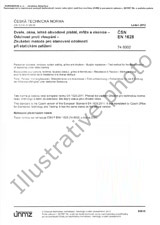We need your consent to use the individual data so that you can see information about your interests, among other things. Click "OK" to give your consent.
ČSN EN 50290-2-38 (347820)
Communication cables - Part 2-38: Common design rules and construction - Polypropylene insulation for coaxial cables
Translate name
STANDARD published on 1.1.2017
The information about the standard:
Designation standards: ČSN EN 50290-2-38
Classification mark: 347820
Catalog number: 500595
Publication date standards: 1.1.2017
SKU: NS-672421
The number of pages: 12
Approximate weight : 36 g (0.08 lbs)
Country: Czech technical standard
Category: Technical standards ČSN
The category - similar standards:
Plastics and rubber insulating materialsCoaxial cables. Waveguides
Annotation of standard text ČSN EN 50290-2-38 (347820):
This Part 2-38 of EN 50290 gives specific requirements for Polypropylene (PP) compounds to be used for the insulation of coaxial cables. It is to be read in conjunction with EN 50290 2 20, EN 50117 and other applicable product standards.
Grades PP-S1 and PP-F1 correspond to materials specified in the previous version 50290-2-25. These relatively soft Polypropylene compounds have good low temperature properties and are highly stabilized.
Grades PP-S2 and PP-F2 exhibit properties more typical of Polypropylene and are designed for general Coax applications where high crush resistance and superior dielectric properties are needed.
Using raw material and type test data as outlined in this standard, the raw material supplier will have sufficient data to demonstrate compliance and warrant that the material is suitable for the specified application
Preview of the standard ČSN EN 50290-2-38 (347820)
We recommend:
Technical standards updating
Do you want to make sure you use only the valid technical standards?
We can offer you a solution which will provide you a monthly overview concerning the updating of standards which you use.
Would you like to know more? Look at this page.




 Cookies
Cookies
